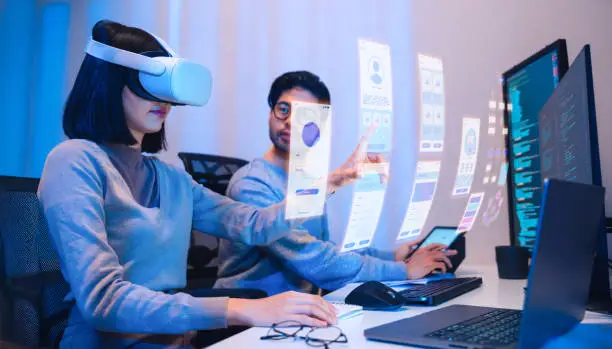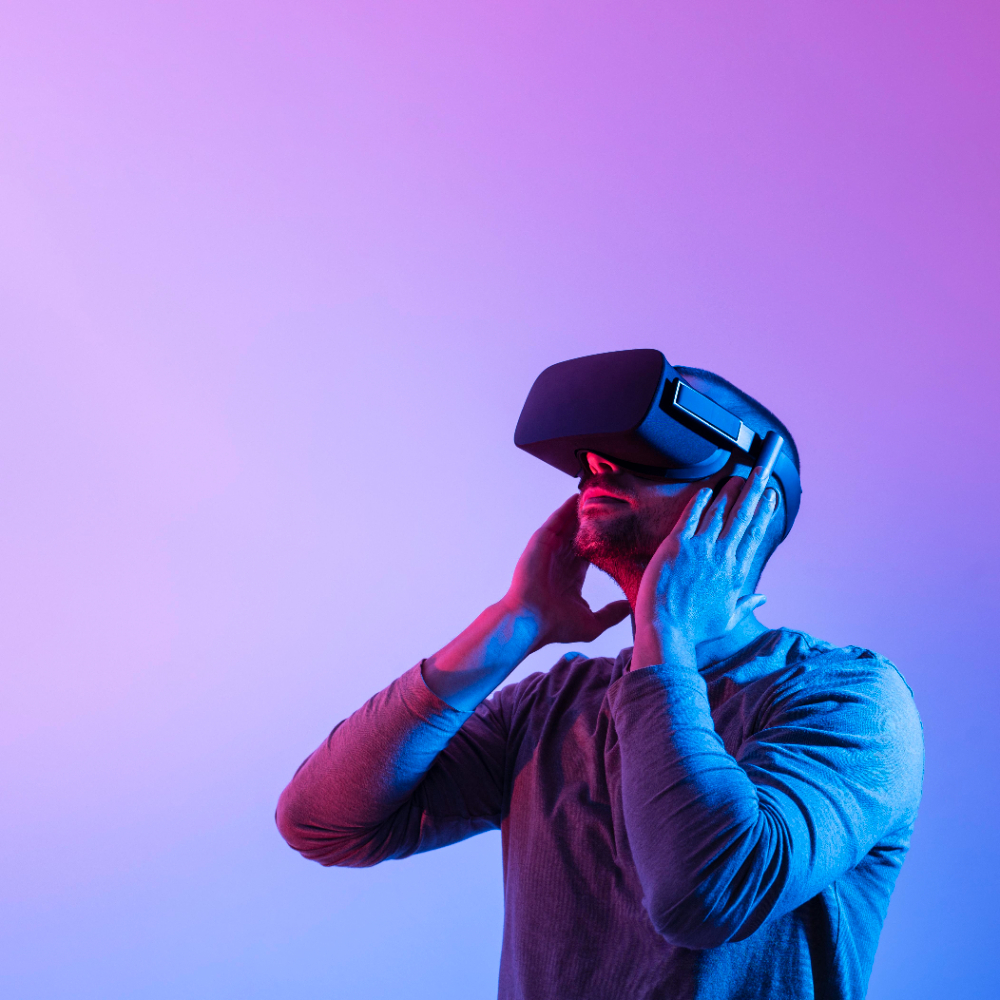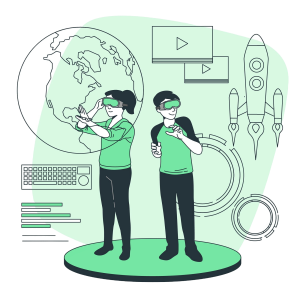Augmented reality (AR) and virtual reality (VR) today represent a major shift in the way a person can communicate and integrate with technology. These two masterpieces have always been an innovation in the United States into bringing industries to almost every corner of the environment-from gaming to education, from healthcare to retail. This article discusses some of the ways in which the USA is spearheading AR and VR Technologies, their main applications, and some of the benefits with which they come for both businesses and consumers.
Defining AR and VR Technologies

Augmented reality is that, firstly, digital information is superimposed on the actual world it is viewed using devices like a smartphone/tablet or AR glasses:
- It adds the interactive ingredient in your normal everyday surroundings.
- Virtual reality, in reality, is an environment that is entirely virtual the available dimensions depend only on the capabilities of your headset, and possible interactions are limited with the hardware attached.
- You can travel around by stretching out hands that hold VR controllers, and, aided by a bunch of other accessories such as sensors and body wear, you can completely control an immersive digital universe.
- Together, AR and VR have set the base for the birth of what is called Extended Reality (XR). This is a collective name given to all immersive technologies.
- The status that the USA enjoys in XR is said to be number one in the world when it comes to giant tech and startup companies’ revenues.
The USA in Establishing Innovations in AR and VR Technologies
- The US has, in pure and effective terms, identified itself as the new home for AR and VR development
- From Silicon Valley to research labs all over the country, companies and universities take part in the ongoing public-private building process and genetic codes on the future of these technologies.
- Big Tech Companies Leading the Way:
- American tech giants like Meta, Apple, and Google are heavily investing in AR and VR.
- The Oculus VR headsets of Meta, along with the Vision Pro of Apple, top the list of modern facilities today.
- These companies are also busy creating ways for developers to more easily build applications in AR and VR.
Incubators of New Ideas:
- These many startups are busily dabbling with new research pieces in America and many more
- Magic Leap, Niantic, Ultraleap, to name just a few of those responsible for creating serious magic in the way people manage and encounter digital material.
Research and Development:
- Such top-notch universities as MIT and Stanford are making research breakthroughs into the AR and VR worlds.
- They are forging partnerships as well between technology companies in creating more and more innovative and practically applicable technology inventions.
New Innovations in Augmented Reality and Virtual Reality
This is among the pioneering countries where one innovates for research in new creation and technologies around augmented reality and virtual reality, such as the following:
- Augmented Reality Glasses and Wearables
- They integrate digital material over the physical world, such as Apple Vision Pro, Magic Leap 2, for several applications such as in architecture, engineering, and healthcare, among others designed for both consumers and professionals
- Technology for Haptic Feedback:
- Haptic feedback, thus, is supposed to supplement virtual reality with a sense of touch.
- Certain companies, such as Ultraleap, manufacture gloves and controllers for enabling users to feel their surroundings and textures inside those areas using haptics and vibrations.
Navigation AR in Real-Time:
- The core of augmented reality, like the Google navigation app, provides directions right away with arrows and landmarks painted into the user’s actual surroundings.
- This aspect makes it really helpful for moving in the city and makes maps easier to use.
Immersive VR Environments:
- The next name in the line of latest virtual reality headsets will be Oculus Quest 3 as it goes much higher than that the previous variants concerning resolution and photorealism in environments. Uses
- Games, virtual meetings, and therapy sessions.
AI in Augmented and Virtual Reality:
- New AI applications, combined with preexisting AR and VR technologies, can upscale personalization and interactivity among built-in AI-powered virtual assistants who can guide people through augmented experiences or improve their VR training simulations.
Applications of AR and VR in the United States
Coming up with innovative inventions and both helping in new solutions to the previous problems as a result of formed opportunities in various sectors such as: – more sources of all these applications.
AR and VR-Aided Gaming Features Events:
- Probably the most famous applications of AR and VR are gaming.
- Perhaps these terms are the best-known in this category: Pokemon Go and Beat Saber. Now, virtual concerts, movies, and sports events are immersing fans in entertainment.
- There has really been increasing momentum around AR and VR in education and training-altering the whole paradigm of teaching within a classroom.
- this is an area where students can undertake virtual travels to an important national heritage site in another country or basically have AR applications conduct for them a scientific experiment without the real environment requirement.
- VR is used in professional training for simulating educational practices in healthcare, aviation, and manufacturing.
Healthcare and Therapy:
- Augmented reality and virtual reality are improving patient care in the USA.
- The former is used for surgical planning, enabling a surgeon to see how to visualize a complicated potential procedure.
- The latter has mainly entered pain therapy treatment along with PTSD and physical rehabilitation.
Retail and E-Commerce:
- AR is used in retail to enable virtual try-ons for clothing, cosmetics, and furniture.
- With an app like IKEA Place, you can see how your future purchases will look in your home before actually purchasing them.
- With the use of virtual reality, shopping has gone a step higher, as customers can explore and shop items maximumly on the full immersive environment.
Architecture- Real Estate-redesign:
- The AR and VR technologies are transforming the whole process of buying, selling, and designing properties.
- Real estate applications such as virtual reality now come with virtual tours, allowing buyers to inspect apartments without leaving their home.
- Architects create 3D models of buildings using VR, where their clients are taken through the designs before the actual construction starts.
- collaborations in workplaces; the integration of GVR into modern work practice.
- As the presentations above imply, workplace collaboration has also moved to virtual spaces, with VR becoming the new technology in virtual meetings and discussions with the introduction of platforms such as Horizon Workrooms, transforming teams into a virtual office for their improvement in communication and productivity.
Advantages of AR and VR Technology Integration
The additions of AR and VR technology into various industries have brought some advantages:
Increased User Engagement:
AR and VR bring interactive experiences to and captivate a user’s audience.
Increase Efficacy:
- With AR and VR’s huge applications in several steps of production processes-training and product development-using these technologies reduces time and resource use.
Improved Accessibility: - AR and VR provide remote access to education, healthcare, and other services that are normally received face to face.
More Personalized Experience: - AR and VR applications personalized their interaction relying on the individual by integrating AI systems.
Economic Development: - The AR and VR industry is building opportunities and enriching the economy by providing numerous job openings among the hubs in the USA.
Challenges: AR and VR Technology.
Conclusion
America leads, indeed, in innovative landmarks among AR and VR places. It lay in wait, while future advances took these technologies into everyday life, increasing experiences in recreation and health, education, and retail.
Numerous hurdles remain regarding these states, which constant technology and investment improvements will spur. With the advancement of these technologies come the new horizons they will present in how individuals live, work, and relate to each other and the outside world beyond the present configurations.
AR and VR will not only boost innovation feats but also define the future by which the rest of the globe will tread while the USA strides into it.



